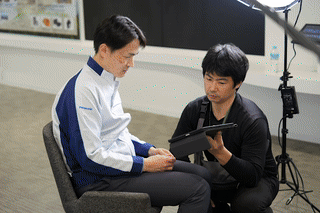This content is provided in partnership with Tokyo-based startup podcast Disrupting Japan. Please enjoy the podcast and the full transcript of this interview on Disrupting Japan's website!
Today we are going to sit down with an old friend.It was over seven years ago when I first had Tim Rowe on the podcast, and we mapped out what we saw as the future of startup innovation in Japan.
In today’s short episode, we talk about what we got right, what surprised us, and what we think is next for Japanese startup innovation.
It’s a great conversation, and I think you’ll enjoy it.


Transcript
Welcome to Disrupting Japan, straight talk from Japan’s most innovative founders and VCs.
I’m Tim Romero, and thanks for joining me.I’d like to share a special short in between episode with you.
Last month I had a fireside chat with Tim Rowe, the founder and CEO of the Cambridge Innovation Center at the Global Venture Cafe’s anniversary celebration in Tokyo. And I thought I would share it with you just as it happened. I first had Tim on the show about eight years ago, just before CIC opened their Big Tokyo collaboration space.
This time Tim and I talk about the changes to the Japanese startup ecosystem since then, what we are likely to see in the future, and we also discuss what might be a new model for startup ecosystems. As startups have become more and more accepted and more and more common. The old community playbook may not be as effective as it once was.
But Tim tells that story much better than I can. So, let’s get right to the interview.
(Part 5 of 6. Continuing from Part 4)
***
Interview

(Continuation of the previous article)
Rowe: Yeah, I think that’s right. And I think one of the things that’s interesting about that customer lever is that it’s one that the governments have the ability to pull. They can either be the customer or they can put together financing or other ways to sort of smooth the path to selling the tech that you need. It’s one of the reasons why dual use defense technology has brought a lot of technologies in all fields forward, because it turned out they were also needed by the Army or whatever, and they end up spending a billion dollars on it, and suddenly a bunch of companies that had no customers get through the learning curve and start selling their products. So, it doesn’t have to be through defense, of course, but that’s one of the ways this customer lever can be pulled.
Romero: Huh. That’s really interesting. In Japan CIC Venture Cafe does a lot of engagement with various localities sometimes even more rural areas in Japan? Can you talk about why that’s important and what ecosystems outside of Tokyo really impress you in Japan? Whose up and coming?
Rowe: Well, that’s sort of an easy one. But first of all, I’ll say why it’s important. I think everywhere in the world has the potential to contribute toward innovation. I think innovation is just new ideas that solve problems. And if those problems are important and they not solving them holds people back or hurts them, if nobody develops cure to your parents’ cancer then your parents’ going to suffer. So, I think generally speaking, the innovation itself is sort of a public good that benefits everyone globally. Probably some innovations are not so good, but by and large, I mean, if you look at the real statistics, you’ll know for instance, that the likelihood that you’ll die from a disease rather than from old age has dropped by like a hundred fold in the last a hundred years. Things have been getting better. We keep thinking they haven’t, or we read the news and it sounds bad, but actually things have gotten much, much better for everybody over the last a hundred years. And innovation is probably the main thing that’s changing. So, that’s a public good. Now, when any place a city steps up and says, hey, we would like to contribute to that, we would like to move innovation forward and they sometimes ask us, how could we do that given our experience elsewhere? We say, yeah, let’s work on this. Let’s figure out what your role can be. There’s a fairly simple, some people say, what could Sapporo do? Or what could Fukuoka do or what have you? And we find there’s always an answer.
The simple way of thinking about it is that if you’re in the biggest, most famous central city, you’re in a Tokyo or London or New York, you can pull off sort of any kind of innovation. You build a beautiful innovation center. You got lots of people in all kinds of industries that does work. If you are in a smaller place, farther out you’ve got to pick a lane. You’ve got to be better than Tokyo or London, New York at something. And there’s some really cool examples of that in Manchester, England. There is an innovation. Manchester’s a great city, by the way, but it’s not the biggest city in the UK. There’s a great innovation center built around graphene. Graphene is a two dimensional lattice of carbon atoms that lock together and create a superconducting surface. It’s also a super slippery surface. They put it on competing boats. If you put it on the hull of your boat, your boat will slide faster through the water. There’s all kinds of uses of graphene, and yet it’s really hard to work with. It’s hard to make. It’s hard to move, it’s hard to apply. And so they built the world’s best center for graphene technology, and essentially every graphene startup in the world has some kind of connection with this center.

So, Manchester made it like the, if you will, the capital of graphene. I think any place can do that. There are enough fields out there that you can pick a field that nobody else is leaning in on and be the best place in the world to pursue that field.
Romero: That really dovetails well with the advice you were giving before the kind of customer top down, identify the problem, become a hub of something. I mean, thinking back, like even when you were establishing CIC, I think innovation needs some distance from power. I mean, you were setting it up in Boston, you didn’t set it up in New York or San Francisco or Chicago, and actually, I guess even San Francisco in the early days was a suburb of a second tier city back in the sixties and seventies when it was…
Rowe: Which would give us all hope, because it means that anywhere can become a San Francisco.
(To be continued in Part 6)
In Part 6, we will discuss the challenges facing Japan’s startup ecosystem, particularly what needs to be done for Japanese startups to succeed globally.
[ This content is provided in partnership with Tokyo-based startup podcast Disrupting Japan. Please enjoy the podcast and the full transcript of this interviewon Disrupting Japan's website! ]
Top photo: Envato
***
Click here for the Japanese version of the article
![[Podcast] How to build a successful startup community ー Interview with Tim Rowe at Cambridge Innovation Center (Part 5)](https://storage.googleapis.com/jstories-cms.appspot.com/images/1751617429032unnamed-6.jpg)
![[Podcast]How to build a successful startup community ー Interview with Tim Rowe at Cambridge Innovation Center (Part 3)](https://storage.googleapis.com/jstories-cms.appspot.com/images/1749116371832unnamed_smallthumbnail.jpg)
![[Podcast]How to build a successful startup community ー Interview with Tim Rowe at Cambridge Innovation Center (Part 2)](https://storage.googleapis.com/jstories-cms.appspot.com/images/1748493203370business-man-holding-light-bulb-social-network-2024-10-31-22-37-36-utc_smallthumbnail.jpg)
![[Podcast] How to build a successful startup community ー Interview with Tim Rowe at Cambridge Innovation Center (Part 4)](https://storage.googleapis.com/jstories-cms.appspot.com/images/1750995302055image2_smallthumbnail.jpg)
![[Podcast]How to build a startup in Japan](https://storage.googleapis.com/jstories-cms.appspot.com/images/1727340966966building-a-start-up-in-japan_smallthumbnail.jpg)

![[Podcast] Japanese technology to supercharge human fertility (Part 3)](https://storage.googleapis.com/jstories-cms.appspot.com/images/1766558713084place-for-scientific-research-2025-03-07-14-08-49-utc%20(1)_bigthumbnail.jpeg)
![[Interview: Part 2] A digital approach to tackle child hunger in Japan with dignity](https://storage.googleapis.com/jstories-cms.appspot.com/images/1766130666509unnamed_bigthumbnail.jpg)
![[Podcast] Japanese technology to supercharge human fertility (Part 2)](https://storage.googleapis.com/jstories-cms.appspot.com/images/1765863548035unnamed-7_bigthumbnail.jpg)
![[Podcast] Japanese technology to supercharge human fertility (Part 1)](https://storage.googleapis.com/jstories-cms.appspot.com/images/1765440905082unnamed_bigthumbnail.jpg)
_bigthumbnail.jpeg)




![[Interview] When digital and physical worlds meet](https://storage.googleapis.com/jstories-cms.appspot.com/images/1747974430456unnamed-2_smallthumbnail.png)

![[Interview] How Japanese musician Grover turned his passion of ‘sound’ into a health-tech startup](https://storage.googleapis.com/jstories-cms.appspot.com/images/1746181078493R7__1407_smallthumbnail.jpg)


_smallthumbnail.jpeg)

![[Interview: Part 1] From nourishing souls to feeding the hungry](https://storage.googleapis.com/jstories-cms.appspot.com/images/1763695595492unnamed_smallthumbnail.jpg)

